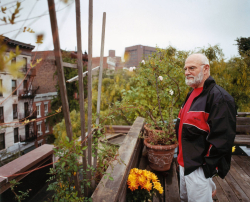Orrin Devinsky in The New Yorker:
 A year ago, I lost my best friend, Oliver Sacks. For many years, each week, Oliver and I would cruise north on the West Side bike path at sunrise. Alone, our bicycles a few inches apart, we spoke about everything and anything, but mostly about interesting patients, natural history, and food. His voice was soft, and I struggled to hear his words. But his volume and pedalling cadence always accelerated when the massive TRUMP PLACE buildings appeared to our right. He detested the giant protuberances that unpleasantly punctuated the view from our bike seats, and often cursed them. Instead, he looked forward to passing by the Seventy-ninth Street Boat Basin, which reminded him of his City Island days. There, he had a housekeeper who, once a week, would make a beef stew for him and divide it into seven daily portions. One day, when the portions began to decline in size, Oliver asked, “Did the price of beef go up? I will give you more.” His housekeeper sheepishly admitted to pilfering some stew; she could not afford it for herself. “Then I will give you money for eight pounds instead of four, and you keep half.”
A year ago, I lost my best friend, Oliver Sacks. For many years, each week, Oliver and I would cruise north on the West Side bike path at sunrise. Alone, our bicycles a few inches apart, we spoke about everything and anything, but mostly about interesting patients, natural history, and food. His voice was soft, and I struggled to hear his words. But his volume and pedalling cadence always accelerated when the massive TRUMP PLACE buildings appeared to our right. He detested the giant protuberances that unpleasantly punctuated the view from our bike seats, and often cursed them. Instead, he looked forward to passing by the Seventy-ninth Street Boat Basin, which reminded him of his City Island days. There, he had a housekeeper who, once a week, would make a beef stew for him and divide it into seven daily portions. One day, when the portions began to decline in size, Oliver asked, “Did the price of beef go up? I will give you more.” His housekeeper sheepishly admitted to pilfering some stew; she could not afford it for herself. “Then I will give you money for eight pounds instead of four, and you keep half.”
We would climb the small hill into Riverside Park’s Ninety-first Street garden for a water stop, and Oliver would become absorbed by a crocus, columbine, hyacinth, or tulip. A stray dandelion once launched a discourse on their unfair label as weeds, the potential diuretic effect of their leaves, their definite edibility (he popped it in his mouth, stem and all), the plant’s name (the coarsely toothed leaves resembled lions’ teeth, leading the French to call it dent de lion), and the paradoxical fecundity of these asexual plants. Almost every living eukaryote—organisms with complex cells, from algae and fungi to plants and animals—reproduces sexually, at least some of the time. But certain dandelion species only reproduce asexually. Oliver predicted their “imminent” extinction, at least in geological time, since “only bdelloid rotifers survived tens of million of years living the sexless life.” It was one of the rare times I had something to add. John Maynard Smith, I told him, considered the bdelloid’s successful asexuality “an evolutionary scandal.”
“Very good,” Oliver agreed, with his broad, mischievous smile.
More here.
Cynthia Haven at The Book Haven:
